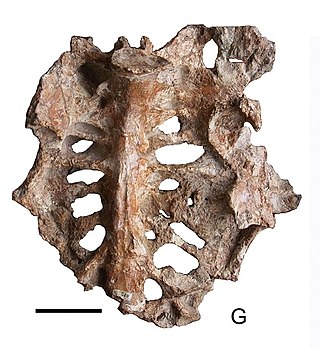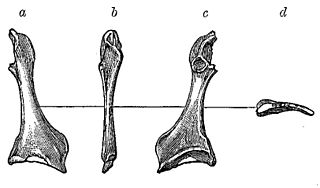
Dinosaurs are a diverse group of reptiles of the clade Dinosauria. They first appeared during the Triassic period, between 243 and 233.23 million years ago (mya), although the exact origin and timing of the evolution of dinosaurs is a subject of active research. They became the dominant terrestrial vertebrates after the Triassic–Jurassic extinction event 201.3 mya and their dominance continued throughout the Jurassic and Cretaceous periods. The fossil record shows that birds are feathered dinosaurs, having evolved from earlier theropods during the Late Jurassic epoch, and are the only dinosaur lineage known to have survived the Cretaceous–Paleogene extinction event approximately 66 mya. Dinosaurs can therefore be divided into avian dinosaurs—birds—and the extinct non-avian dinosaurs, which are all dinosaurs other than birds.
The Late Cretaceous is the younger of two epochs into which the Cretaceous Period is divided in the geologic time scale. Rock strata from this epoch form the Upper Cretaceous Series. The Cretaceous is named after creta, the Latin word for the white limestone known as chalk. The chalk of northern France and the white cliffs of south-eastern England date from the Cretaceous Period.

The Enantiornithes, also known as enantiornithines or enantiornitheans in literature, are a group of extinct avialans, the most abundant and diverse group known from the Mesozoic era. Almost all retained teeth and clawed fingers on each wing, but otherwise looked much like modern birds externally. Over eighty species of Enantiornithes have been named, but some names represent only single bones, so it is likely that not all are valid. The Enantiornithes became extinct at the Cretaceous–Paleogene boundary, along with Hesperornithes and all other non-avian dinosaurs.

Hesperornithes is an extinct and highly specialized group of aquatic avialans closely related to the ancestors of modern birds. They inhabited both marine and freshwater habitats in the Northern Hemisphere, and include genera such as Hesperornis, Parahesperornis, Baptornis, Enaliornis, and Potamornis, all strong-swimming, predatory divers. Many of the species most specialized for swimming were completely flightless. The largest known hesperornithean, Canadaga arctica, may have reached a maximum adult length of 2.2 metres (7.2 ft).

Ichthyornis is an extinct genus of toothy seabird-like ornithuran from the late Cretaceous period of North America. Its fossil remains are known from the chalks of Alberta, Alabama, Kansas, New Mexico, Saskatchewan, and Texas, in strata that were laid down in the Western Interior Seaway during the Turonian through Campanian ages, about 95–83.5 million years ago. Ichthyornis is a common component of the Niobrara Formation fauna, and numerous specimens have been found.

The evolution of birds began in the Jurassic Period, with the earliest birds derived from a clade of theropod dinosaurs named Paraves. Birds are categorized as a biological class, Aves. For more than a century, the small theropod dinosaur Archaeopteryx lithographica from the Late Jurassic period was considered to have been the earliest bird. Modern phylogenies place birds in the dinosaur clade Theropoda. According to the current consensus, Aves and a sister group, the order Crocodilia, together are the sole living members of an unranked reptile clade, the Archosauria. Four distinct lineages of bird survived the Cretaceous–Paleogene extinction event 66 million years ago, giving rise to ostriches and relatives (Palaeognathae), waterfowl (Anseriformes), ground-living fowl (Galliformes), and "modern birds" (Neoaves).

Sapeornis is a monotypic genus of avialan dinosaurs which lived during the early Cretaceous period. Sapeornis contains only one species, Sapeornis chaoyangensis.

The Pelagornithidae, commonly called pelagornithids, pseudodontorns, bony-toothed birds, false-toothed birds or pseudotooth birds, are a prehistoric family of large seabirds. Their fossil remains have been found all over the world in rocks dating between the Early Paleocene and the Pliocene-Pleistocene boundary.

Gargantuavis is an extinct genus of large, primitive bird containing the single species Gargantuavis philoinos. It is the only member of the monotypic family Gargantuaviidae. Its fossils were discovered in several formations dating to 73.5 and 71.5 million years ago in what is now northern Spain, southern France, and Romania. Gargantuavis is the largest known bird of the Mesozoic, a size ranging between the cassowary and the ostrich, and a mass of 141 kg (311 lb) like modern ostriches, exemplifying the extinction of non-avian dinosaurs was not a necessary condition for the emergence of giant terrestrial birds. It was once thought to be closely related to modern birds, but the 2019 discovery of a pelvis from what was Hateg Island shows several primitive features.

Yixianornis is a bird genus from the early Cretaceous period. Its remains have been found in the Jiufotang Formation at Chaoyang dated to the early Aptian age, around 120 million years ago. Only one species, Yixianornis grabaui, is known at present. The specific name, grabaui, is named after American paleontologist Amadeus William Grabau, who surveyed China in the early 20th century.
Ambiortus is an extinct genus of ornithuromorph dinosaurs. The only known species, Ambiortus dementjevi, lived sometime during the Barremian age between 136.4 and 125 million years ago in the Andaikhudag Formation of Mongolia. It was discovered by Yevgeny Kurochkin in 1982.

Apatornis is a genus of ornithuran dinosaurs endemic to North America during the late Cretaceous. It currently contains a single species, Apatornis celer, which lived around the Santonian-Campanian boundary, dated to about 83.5 million years ago. The remains of this species were found in the Smoky Hill Chalk of the Niobrara Formation in Kansas, United States. It is known from a single fossil specimen: a synsacrum, the fused series of vertebrae over the hips.

Cimolopteryx is a prehistoric bird genus from the Late Cretaceous Period. It is currently thought to contain only a single species, Cimolopteryx rara. The only specimen confidently attributed to C. rara was found in the Lance Formation of Wyoming, dating to the end of the Maastrichtian age, which ended about 66 million years ago. The dubious species "Cimolopteryx" maxima has been described from both the Lance Formation and the Hell Creek Formation of Montana. The humeral end of a left coracoid from the Frenchman Formation of southern Saskatchewan has also been attributed to the genus.
Iaceornis is a genus of marine ornithuran dinosaurs closely related to modern birds. It was endemic to North America during the Late Cretaceous, living about 83.5 million years ago. It is known from a single fossil specimen found in Gove County, Kansas (USA), and consisting of a partial skeleton lacking a skull.
Qinornis is a prehistoric bird genus from the early-mid-Paleocene epoch, about 61 million years ago. It is known from a single fossil specimen consisting of a partial hind limb and foot, which was found in Fangou Formation deposits in Luonan County, China.
Ambiortiformes is a group of prehistoric ornithuromorph dinosaurs.
Cerebavis is an extinct genus of ornithurine dinosaurs that lived during the middle Cenomanian of the Late Cretaceous period, and is known from a single partial skull found in the Melovatskaya Formation of Volgograd Region in Russia. The skull was initially described as the fossilised brain of an enantiornithean by Russian palaeornithologist Evgeny Kurochkin and colleagues in 2006. Kurochkin and colleagues described Cerebavis as having a notable mixture of ancestral traits, such as a well-developed olfactory system, with derived traits of modern birds like a large cerebrum. At the same time, they identified various unusual and unique features not seen in the brains of reptiles or birds. These include well-developed auditory tubercles on the midbrain, as well as a prominent parietal organ compared to living birds or Archaeopteryx between them.

The biogeography of Paravian dinosaurs is the study of the global distribution of Paraves through geological history. Paraves is a clade that includes all of the Theropoda that are more closely related to birds than to oviraptorosaurs. These include Dromaeosauridae and Troodontidae and Avialae. The distribution of paraves is closely related to the evolution of the clade. Understanding the changes in their distributions may shed light on problems like how and why paraves evolve, eventually gaining the ability to fly.

Asteriornis is an extinct genus of bird from the Late Cretaceous of Belgium which is known from a single species, Asteriornis maastrichtensis. It was closely related to birds of the extant superorder Galloanserae such as chickens and ducks. Members of the genus were small, long-legged birds that lived near the coastline and co-existed with more "primitive" types of birds such as Ichthyornis. Asteriornis is one of the oldest-known birds irrefutably belonging to the group Neornithes, which encompasses all modern birds. It possesses characteristics of both galliformes and anseriformes, indicating its position as a close relative of the last common ancestor for both groups.
Janavis is an extinct toothed bird, belonging to the Ichthyornithes, from the Late Cretaceous of Belgium. The genus has one named species, Janavis finalidens that was discovered in the 1990s, reported in 2002, and described in 2022. Recovered almost simultaneously from the same area and age as Asteriornis maastrichtensis, then the oldest known modern bird, it provides information on the evolution and divergence of basal and modern birds, especially on the evolutionary modifications of bird skulls.























